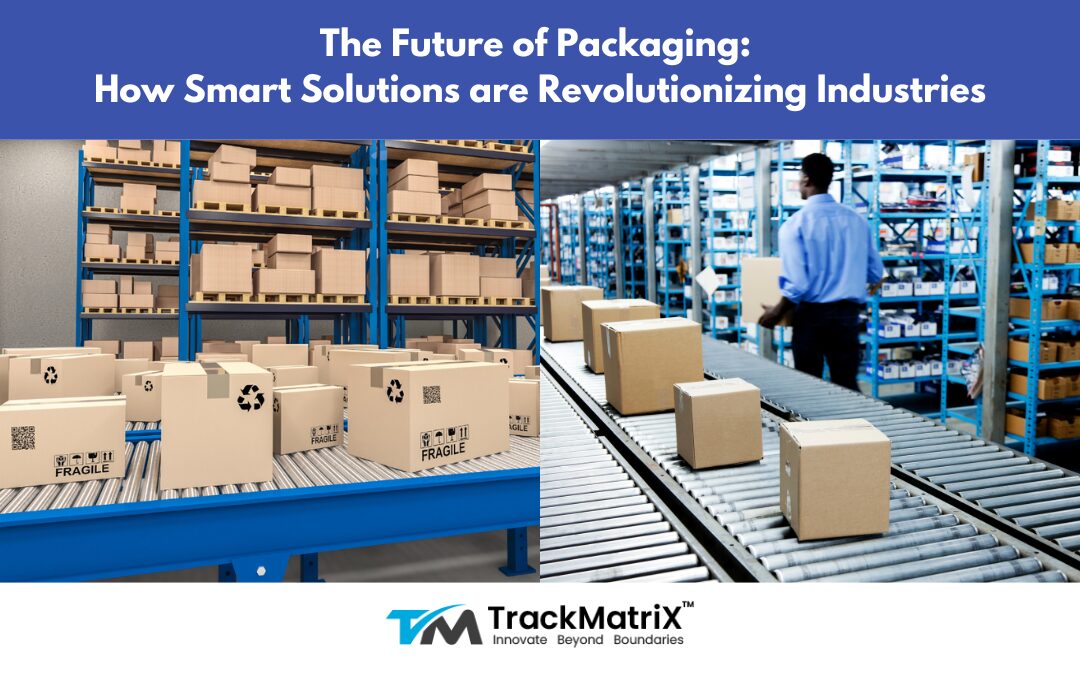Smart Packaging Solutions
The Future of Packaging: How Smart Solutions are Revolutionizing Industries
- By Alfons Futterer
- No Comments
08 Mar

Introduction
Packaging plays a pivotal role that extends far beyond its traditional functions of containment and protection. As consumer expectations continue to evolve and technological advancements reshape industries, the concept of packaging has undergone a profound transformation. This transformation is epitomized by the emergence of smart packaging solutions, which represent a fusion of cutting-edge technologies and innovative design concepts aimed at enhancing the overall product experience.
In 2022, the worldwide smart packaging market reached a value of USD 35.92 billion, projected to climb to approximately USD 60.49 billion by 2032. As enterprises maneuver through this dynamic environment, smart packaging surfaces as a vital asset for maintaining competitiveness and addressing the changing demands of customers. It enables companies to provide enriched product experiences, streamline supply chain operations, and foster consumer trust.
In this blog post, we embark on a journey to explore the transformative power of smart packaging in detail. From its underlying technologies to real-world examples and future predictions, we’ll uncover how smart packaging is reshaping industries and redefining the future of packaging. Join us as we dive into this exciting topic and discover its potential for businesses and consumers alike.
Understanding Smart Packaging
In today’s ever-evolving market landscape, smart packaging stands at the forefront of innovation, revolutionizing the way products are packaged, distributed, and perceived by consumers. Unlike conventional packaging, which primarily focuses on containment and protection, smart packaging integrates cutting-edge technologies to provide an interactive and value-added experience throughout the product life cycle. Going beyond mere containment, it incorporates RFID, sensors, QR codes, and other IoT devices. These technologies enable packaging to interact with consumers, manufacturers, and supply chains, delivering real-time information and enriching overall product experiences.
Smart packaging is dynamic and forward-thinking, unlike the static nature of traditional packaging. It actively engages with stakeholders, gathers data, and responds to external stimuli, offering functionalities that traditional packaging cannot replicate.
How Is Smart Packaging Different From Traditional Packaging?
Smart packaging is a groundbreaking evolution from traditional methods, transforming how products are packaged and experienced by consumers. Unlike standard packaging that merely protects products, smart packaging incorporates advanced technologies for an interactive product encounter.
What sets smart packaging apart is its real-time engagement and responsiveness. By utilizing RFID tags, sensors, and QR codes, smart packaging goes beyond the static nature of traditional packaging. These elements provide consumers with immediate access to detailed product information, such as ingredients, nutrition facts, and usage instructions. Additionally, smart packaging actively monitors product conditions to ensure freshness, safety, and quality throughout its lifecycle.
Furthermore, smart packaging nurtures stronger brand-consumer relationships by seamlessly connecting with digital devices like smartphones. This connectivity allows consumers to access exclusive content, benefit from promotions, and engage in interactive experiences directly from the packaging, resulting in personalized and immersive interactions.
The Technological Foundation of Smart Packaging
- RFID (Radio Frequency Identification): RFID tags integrated into packaging facilitate seamless track-and-trace of products along the supply chain. These tags can hold unique identifiers and product details, enhancing inventory management and combating counterfeiting.
- Sensors: Smart packaging includes diverse sensors like temperature, humidity, and gas sensors to monitor product conditions in real time. For instance, in the food sector, sensors detect temperature changes to ensure the freshness and safety of perishable items.
- QR Codes: Quick Response (QR) codes are extensively utilized in smart packaging to offer consumers instant access to product details, promotions, and interactive experiences. By scanning QR codes using their smartphones, consumers can connect with brands, access nutritional data, and authenticate products.
Applications and Advantages of Smart Packaging Across Various Industries
Smart packaging represents a convergence of technology and design, redefining the traditional role of packaging from passive containment to an active tool for engagement, information dissemination, and brand differentiation. By integrating advanced features such as RFID, sensors, and interactive elements, smart packaging not only enhances the consumer experience but also offers tangible benefits for businesses across the entire supply chain. Now, let’s explore the diverse applications and benefits of smart packaging across various industries.
Retail
- Enhanced Customer Experience: Smart packaging enhances the overall shopping experience by providing interactive features such as QR codes, NFC tags, or augmented reality. These features allow customers to access additional product information, promotional offers, and engaging content directly from the packaging, fostering a deeper connection with the brand and increasing customer satisfaction.
- Improved Brand Engagement: Smart packaging enables brands to differentiate themselves in a crowded marketplace by offering unique and memorable packaging experiences. Interactive features and personalized content drive brand engagement, increase brand loyalty and encourage repeat purchases, ultimately boosting sales and revenue.
- Streamlined Inventory Management: Smart packaging provides real-time tracking and monitoring capabilities that streamline inventory management processes for retailers. By accurately tracking product movement and stock levels throughout the supply chain, retailers can optimize inventory levels, reduce stockouts, and improve overall operational efficiency.
Logistics
- Optimized Supply Chain Visibility: Smart packaging offers real-time tracking and monitoring capabilities that provide logistics companies with unprecedented visibility into their supply chains. By accurately tracking the location and condition of products in transit, logistics companies can optimize route planning, reduce transportation costs, and improve overall supply chain efficiency.
- Proactive Issue Resolution: Smart packaging enables logistics companies to proactively address issues such as temperature deviations, tampering, or delays in transit. Real-time alerts and notifications allow logistics companies to quickly identify and resolve issues before they escalate, ensuring product safety and quality throughout the supply chain.
- Improved Customer Satisfaction: Smart packaging ensures timely deliveries and product availability, leading to improved customer satisfaction. By optimizing logistics processes and minimizing delivery delays or stockouts, logistics companies can enhance the overall customer experience and strengthen customer loyalty.
Manufacturing
- Data-Driven Decision-Making: Smart packaging generates valuable data insights that enable manufacturers to make informed business decisions. By analyzing data on consumer behavior, product performance, and supply chain efficiency, manufacturers can optimize production processes, improve product design, and enhance operational efficiency.
- Product Authentication and Brand Protection: Smart packaging integrates anti-counterfeiting measures such as RFID tags and QR codes, which help manufacturers protect their brands and products from counterfeiters. By ensuring product authenticity, manufacturers can safeguard brand reputation, build consumer trust, and mitigate the risk of counterfeit products entering the market.
- Streamlined Supply Chain Collaboration: Smart packaging facilitates seamless collaboration between manufacturers and suppliers by providing real-time visibility into inventory levels, production schedules, and demand forecasts. This transparency enables manufacturers to work closely with suppliers to optimize supply chain processes, reduce lead times, and meet customer demands more effectively.
As industries continue to embrace smart packaging solutions, the future holds endless possibilities for innovation and transformation in packaging and beyond.
Exploring the Challenges and Considerations of Smart Packaging
As businesses explore the adoption of smart packaging solutions, several challenges and considerations must be addressed to ensure successful implementation and maximize the benefits of these innovative technologies.
Privacy and Security
One of the primary concerns associated with smart packaging is the balance between data collection and consumer privacy. Smart packaging solutions often involve the collection of data through sensors, RFID tags, and other technologies to enable real-time tracking and monitoring. However, businesses must navigate the delicate balance between leveraging this data to enhance operational efficiency while respecting consumer privacy rights. Safeguarding sensitive information and implementing robust data protection measures are crucial to building consumer trust and compliance with privacy regulations.
Cost and Implementation
The investment required for adopting smart packaging can be a significant barrier for businesses, particularly small and medium-sized enterprises (SMEs). The costs associated with acquiring and implementing smart packaging technologies, including hardware, software, and training, can be substantial. Additionally, integrating smart packaging solutions into existing operations may require infrastructure upgrades and changes to existing processes, further adding to the implementation costs. Businesses must carefully evaluate the return on investment (ROI) and develop a comprehensive implementation plan to mitigate financial risks and ensure successful adoption.
Standardization
The lack of uniform standards across industries poses another challenge for businesses considering smart packaging solutions. With various technologies, formats, and communication protocols available in the market, interoperability and compatibility issues may arise when integrating different smart packaging systems into existing supply chain networks. Standardization efforts are essential to ensure seamless integration, data exchange, and interoperability between smart packaging solutions used by different stakeholders Collaborative initiatives and industry-wide standards are needed to address these challenges and establish a cohesive framework for smart packaging adoption.
By proactively addressing these challenges and considerations, businesses can overcome barriers to adoption and unlock the full potential of smart packaging to drive operational efficiency, enhance customer satisfaction, and achieve sustainable growth.
What The Future Holds for Smart Packaging
As technology continues to evolve, smart packaging is poised to revolutionize industries in exciting and transformative ways. Here are some predictions for the future of this innovative packaging solution:
Integration with IoT
Smart packaging will seamlessly integrate with the Internet of Things (IoT), creating interconnected ecosystems within operations. Imagine a world where product packaging communicates directly with IoT devices, providing real-time data on inventory levels, product location, and condition. This integration will not only enhance operational efficiency but also improve supply chain visibility and customer experiences.
Personalization
Customization will become a hallmark of smart packaging. Brands will leverage smart packaging technologies to personalize the packaging experience for individual consumers. Whether it’s customized product recommendations, interactive packaging labels, or personalized promotions, smart packaging will enable businesses to forge deeper connections with their customers and drive brand loyalty.
Environmental Impact
Eco-friendly smart packaging will take center stage as sustainability becomes increasingly important. Businesses will prioritize the use of recyclable materials, biodegradable sensors, and energy-efficient labels to minimize environmental impact. From eco-friendly packaging materials to sustainable supply chain practices, the future of smart packaging will be defined by its commitment to sustainability and environmental stewardship.
Conclusion
In wrapping up our dive into smart packaging, we’ve unveiled a realm of innovation and opportunity that spans industries. By incorporating advanced technologies like RFID, sensors, and QR codes, smart packaging has transcended its traditional role to provide agile solutions to contemporary challenges. Throughout our expedition, we’ve observed how smart packaging enriches customer experiences, streamlines supply chain management, and boosts operational efficiency.
Peering into the horizon, the future of smart packaging holds immense potential. Through sustained innovation and collaboration, businesses can unlock fresh prospects, reshaping sectors and establishing novel benchmarks for packaging excellence. In this ever-evolving panorama, prosperity hinges on embracing change and maintaining a forward-thinking approach. Smart packaging empowers businesses to achieve precisely that, positioning them for success in an increasingly competitive landscape.
As we conclude, let’s keep in mind that the essence of smart packaging lies not only in its technological prowess but also in its capacity to drive substantive transformation and deliver tangible value to customers. By embracing smart packaging, businesses can navigate towards a brighter, more efficient future, fostering an environment where innovation flourishes and success transcends limits.
About TrackMatriX Technologies Limited
TrackMatriX is a leading AI-enabled solution provider, technology developer, and system integrator dedicated to accelerating growth for retail, logistics, and manufacturing businesses. TrackMatriX provides brand protection, advanced digitalization, AI, AR, and SaaS development solutions for better business growth, personalized product experiences, and maximized customer engagement. TrackMatriX serves as your business partner for boosting revenue, protecting your brand identity, and providing you with advanced, scalable, and cyber-secure cloud-based, AI, and AR systems. In 2012, TrackMatriX® developed and patented the TrackMatriX® SaaS platform for digital authentication with mobile phone, product authentication, and consumer engagement.
Recent Posts
- Strengthening Cybersecurity for E-Commerce Websites Against Cyberattacks
- Why Choose TrackMatriX for a White-Label E-Commerce Track-and-Trace Platform
- Your Guide to Developing a Business Strategy for White-Label E-Commerce Track & Trace Platforms
- Boost Your Business with a White-Label E-Commerce Track & Trace Platform
- Unlocking the Potential of Smart Packaging Solutions for Your Business
Quick Links
Applications







